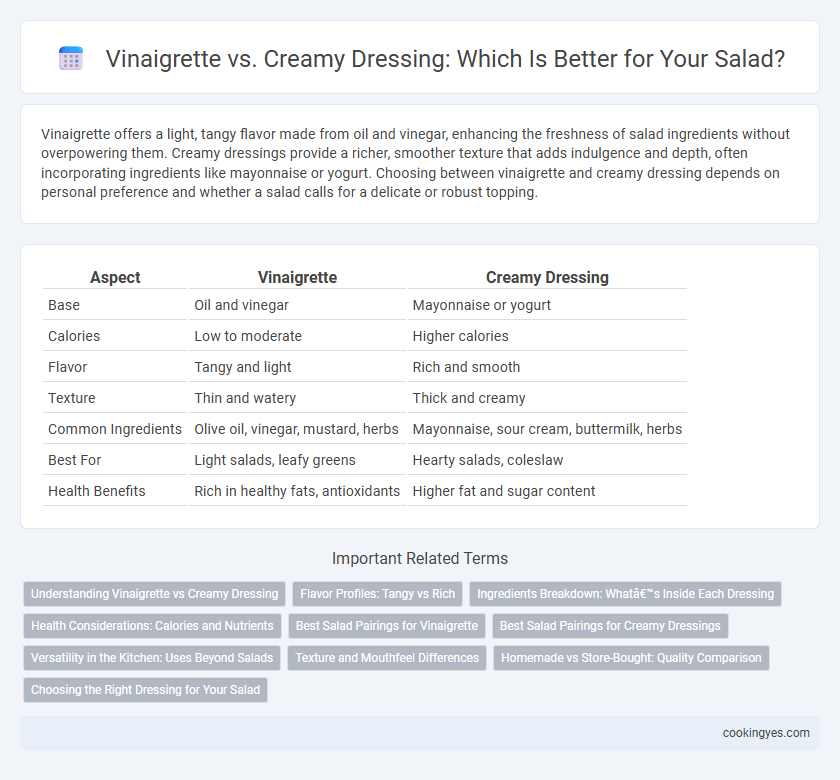Vinaigrette offers a light, tangy flavor made from oil and vinegar, enhancing the freshness of salad ingredients without overpowering them. Creamy dressings provide a richer, smoother texture that adds indulgence and depth, often incorporating ingredients like mayonnaise or yogurt. Choosing between vinaigrette and creamy dressing depends on personal preference and whether a salad calls for a delicate or robust topping.
Table of Comparison
| Aspect | Vinaigrette | Creamy Dressing |
|---|---|---|
| Base | Oil and vinegar | Mayonnaise or yogurt |
| Calories | Low to moderate | Higher calories |
| Flavor | Tangy and light | Rich and smooth |
| Texture | Thin and watery | Thick and creamy |
| Common Ingredients | Olive oil, vinegar, mustard, herbs | Mayonnaise, sour cream, buttermilk, herbs |
| Best For | Light salads, leafy greens | Hearty salads, coleslaw |
| Health Benefits | Rich in healthy fats, antioxidants | Higher fat and sugar content |
Understanding Vinaigrette vs Creamy Dressing
Vinaigrette dressing, typically made from a blend of oil, vinegar, and herbs, offers a light, tangy flavor that enhances the freshness of salad greens without overpowering them. Creamy dressings, such as ranch or Caesar, contain dairy or mayonnaise bases, providing a rich and smooth texture with a more indulgent taste. Understanding the difference helps salad enthusiasts choose dressings that complement specific ingredients, balancing flavor and nutrition preferences.
Flavor Profiles: Tangy vs Rich
Vinaigrette offers a tangy flavor profile, combining vinegar or citrus with oil for a light, zesty finish that enhances fresh vegetables. Creamy dressings deliver a rich, velvety texture with ingredients like mayonnaise or sour cream, adding depth and indulgence to salads. Choosing between the two depends on whether a crisp, acidic bite or a smooth, savory richness is preferred.
Ingredients Breakdown: What’s Inside Each Dressing
Vinaigrette dressings primarily consist of oil, vinegar, and seasonings such as mustard, herbs, and garlic, offering a lighter, tangy flavor profile rich in healthy fats and antioxidants from olive oil. Creamy dressings include ingredients like mayonnaise, sour cream, or yogurt combined with herbs and spices, delivering a thicker texture and higher calorie content due to added dairy and oils. The difference in base ingredients affects not only texture but also the nutritional value and suitability for different types of salads.
Health Considerations: Calories and Nutrients
Vinaigrette dressings typically contain fewer calories and less saturated fat compared to creamy dressings, making them a healthier option for calorie-conscious individuals. They often include heart-healthy oils like olive oil and vinegar, which provide antioxidants and beneficial fats. Creamy dressings tend to be higher in calories, saturated fat, and added sugars, potentially impacting weight management and cardiovascular health.
Best Salad Pairings for Vinaigrette
Vinaigrette dressing, made from oil and vinegar, pairs best with crisp greens like arugula, spinach, and mixed lettuces, enhancing their fresh flavors without overpowering them. Its tangy profile complements ingredients such as cherry tomatoes, cucumbers, red onions, and feta cheese, creating a balanced and vibrant salad. Light vinaigrettes also work well with grilled vegetables, quinoa, and nuts, offering a versatile and healthy salad option.
Best Salad Pairings for Creamy Dressings
Creamy dressings such as Ranch, Caesar, and Blue Cheese excel when paired with hearty, robust salads featuring ingredients like grilled chicken, bacon, and crunchy croutons. They enhance the texture and flavor of salads containing bitter greens like kale or radicchio, as well as creamy elements like avocado and cheese. These dressings add richness and balance to bold flavors, making them ideal for Cobb, wedge, and chef salads.
Versatility in the Kitchen: Uses Beyond Salads
Vinaigrette offers unmatched versatility beyond salads, excelling as a marinade for grilled meats, a drizzle for roasted vegetables, and a tangy sauce for grain bowls. Creamy dressings, rich and indulgent, serve as flavorful dips for fresh vegetables, spreads for sandwiches, and bases for creamy pasta dishes. Both dressings enhance diverse culinary applications, with vinaigrette providing lighter, acidic notes and creamy dressings delivering rich, smooth textures.
Texture and Mouthfeel Differences
Vinaigrette dressings offer a light, tangy texture that enhances a salad's crispness with a refreshing, zesty mouthfeel. Creamy dressings provide a rich, smooth consistency that coats each leaf, creating a velvety and indulgent sensation. The choice between vinaigrette and creamy dressing significantly impacts the overall salad experience, balancing between crisp freshness and luscious creaminess.
Homemade vs Store-Bought: Quality Comparison
Homemade vinaigrette offers fresher, high-quality ingredients like extra virgin olive oil and raw vinegar, providing a vibrant flavor and healthier profile compared to many store-bought options often loaded with preservatives and artificial additives. Creamy dressings, when made from scratch using Greek yogurt or avocado, ensure control over fat content and avoid hidden sugars, unlike store-bought varieties that frequently contain stabilizers and excess sodium. Homemade dressings maximize nutrient retention and customization, making them superior for enhancing salad toppings with natural taste and superior quality.
Choosing the Right Dressing for Your Salad
Vinaigrette dressings, made from oil and vinegar, offer a light, tangy flavor that enhances fresh greens without overwhelming their natural taste, making them ideal for vegetable or fruit-based salads. Creamy dressings, rich in ingredients like mayonnaise or yogurt, provide a thicker texture and a more indulgent flavor, perfect for hearty salads with robust ingredients such as chicken or bacon. Selecting the right salad dressing depends on balancing texture and flavor profiles to complement the ingredients and desired health benefits.
Vinaigrette vs Creamy dressing for salad topping Infographic

 cookingyes.com
cookingyes.com